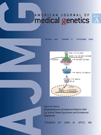Importance of PORCN and Wnt signaling pathways in embryogenesis†
How to cite this article: Clements SE. 2009. Importance of PORCN and Wnt signaling pathways in embryogenesis. Am J Med Genet Part A 149A:2050–2051.
TO THE EDITOR:
Focal dermal hypoplasia (FDH; Goltz syndrome) (OMIM 305600) is a rare X-linked dominant ecto-mesodermal dysplasia syndrome characterized by linear streaks of hypoplastic dermis, hypo- or hyper-pigmentation and subcutaneous fat herniation occurring along the lines of Blaschko [Goltz et al., 1962]. Patients may also have dystrophic nails, sparse hair, hypodontia, mental retardation, and ocular abnormalities including colobomas and microphthalmia. Skeletal defects such as limb hypoplasia, syndactyly, and ectrodactyly are commonly observed and affected individuals may develop striated areas of reduced bone density which is visible on radiographs of long bones (osteopathia striata).
In 2007, mutations in the PORCN gene (Xp11.23) were identified as the molecular basis for FDH [Grzeschik et al., 2007; Wang et al., 2007] and, to date, 57 different mutations have been reported [Grzeschik et al., 2007; Wang et al., 2007; Clements et al., 2008; Leoyklang et al., 2008; Bornholdt et al., 2009; Clements et al., 2009; Harmsen et al., 2009; Schaffer et al., 2009]. PORCN is homologous to the multi-pass Drosophila segment polarity gene porcupine (Porc), which encodes a putative transmembrane O-acyltransferase enzyme in the endoplasmic reticulum (ER). Porc facilitates the palmitoylation and secretion of Drosophila Wingless (Wg), intimating a similar role for PORCN in the secretion of Wnt proteins critical for embryonic tissue development in humans.
The term “Wnt” was derived by combining the names of two genes found to be homologous—the Drosophila wingless (Wg) gene (mutations in which produce flies without wings), and the Int-1 gene found in mouse tumors. There are 19 known Wnt family members in mammals and their signaling pathways play crucial roles in the regulation of stem cells, cell proliferation, differentiation, and embryonic development. At a molecular level, Wnts function as locally active cytosine-rich glycoproteins that bind to cell surface receptors. In the canonical pathway, Wnts interact with transmembrane Frizzled (Fz) and LRP co-receptors, leading to increased levels of stabilized β-catenin in the cytoplasm. β-catenin subsequently translocates to the nucleus where it binds to T-cell factor (Tcf) and lymphoid enhancer factor (Lef) transcription factors to activate target gene expression.
The predominant manifestations of FDH result from the abnormal development of skin and bones, tissues where Wnt signaling pathways are known to be important during embryogenesis. Furthermore, Wnts are involved in the induction of tooth development, myogenesis, neural development and early limb patterning. Therefore, FDH illustrates the phenotypic consequences of defective modulation of Wnt signaling in utero and highlights the important roles of PORCN and Wnt signaling pathways in embryogenesis.




